The SSCT method for the diagnosis of Echinococcus multilocularis ...
The SSCT method for the diagnosis of Echinococcus multilocularis ...
The SSCT method for the diagnosis of Echinococcus multilocularis ...
Create successful ePaper yourself
Turn your PDF publications into a flip-book with our unique Google optimized e-Paper software.
ANSES Nancy,<br />
National Reference<br />
Laboratory<br />
Franck BOUE<br />
WHO collaborating centre <strong>for</strong> research on zoonosis<br />
OIE reference laboratory <strong>for</strong> rabies<br />
CRL <strong>for</strong> rabies<br />
MINISTERE<br />
DE L’AGRICULTURE<br />
ET DE LA PÊCHE<br />
NRL <strong>for</strong> rabies and echinococcosis <strong>for</strong> agriculture minister
SEGMENTAL SEDIMENTATION AND COUNTING<br />
TECHNIQUE (<strong>SSCT</strong>): AN ADAPTABLE METHOD FOR<br />
QUALITATIVE DIAGNOSIS OF ECHINOCOCCUS<br />
MULTILOCULARIS IN FOX INTESTINES<br />
G. Umhang (1) , N. Woron<strong>of</strong>f-Rehn (2) , JM. Boucher (1) , V. Hormaz (1) ,<br />
C. Caillot (1) , B. Combes (3) , F. Boué (1) .<br />
(1) ANSES Nancy, National Reference Laboratory, BP 40009, 54220 Malzéville - France<br />
(2) Laboratoire Vétérinaire Départemental du Doubs, 13, rue Gay Lussac- BP 1981- 25020 Besançon Cedex-France.<br />
(3) ERZ, Domaine de Pixerécourt, 54220 Malzéville
QUICK METHOD FOR DEPARTMENTAL VETERINARY LABORATORIES<br />
In <strong>the</strong> Em national surveillance programme<br />
involving night shooting and analyse <strong>of</strong><br />
intestinal content on a large number <strong>of</strong> foxes<br />
have been examinate.<br />
In this context it has been propose an<br />
optimisation <strong>of</strong> <strong>the</strong> initial SCT technique.<br />
Based on previous experience, a modified<br />
SCT <strong>method</strong> call ‘‘Segmental Sedimentation<br />
and Counting Technique’’ (<strong>SSCT</strong>), has been<br />
adapted <strong>for</strong> <strong>the</strong> routine analysis <strong>of</strong> a large<br />
number <strong>of</strong> intestinal content.<br />
<strong>The</strong> aim was to determine <strong>the</strong> sensitivity,<br />
specificity, and <strong>the</strong> parameters <strong>of</strong> <strong>SSCT</strong><br />
<strong>method</strong>, in order to save time <strong>of</strong> analysis and<br />
retain <strong>the</strong> ‘‘gold standard’’ characteristics.
Comparison to gold standard <strong>method</strong> SCT<br />
SCT<br />
<strong>SSCT</strong><br />
S1 S2 S3 S4 S5
Samples distribution<br />
Laboratory Number Qualitative result Worm burden<br />
VDL 227 Yes ND<br />
Anses 131 Yes Yes<br />
Total 358<br />
Neg n =241<br />
67.3%<br />
Pos n =117<br />
32.7%<br />
Classical SCT (Eckert,2003; H<strong>of</strong>er ,2000)
Burden charge <strong>of</strong> <strong>Echinococcus</strong> <strong>multilocularis</strong><br />
50%<br />
40%<br />
<strong>The</strong> worm burden<br />
distribution has<br />
been determinated<br />
on <strong>the</strong> 53 positive<br />
intestines analysed<br />
at <strong>the</strong> French NRL<br />
30%<br />
20%<br />
10%<br />
0%<br />
1 2 3 4 5<br />
S1 S2 S3 S4 S5<br />
Distribution <strong>of</strong> burden charge <strong>of</strong> <strong>Echinococcus</strong><br />
<strong>multilocularis</strong> in <strong>the</strong> foxes intestines<br />
Preferential localisation <strong>of</strong> <strong>Echinococcus</strong> <strong>multilocularis</strong> adult worms<br />
in <strong>the</strong> posterior part <strong>of</strong> <strong>the</strong> intestine in definitive host.
Sensitivity determination <strong>for</strong> each individual segment<br />
Using <strong>the</strong> 117 positive intestines, we have determinated <strong>the</strong> sensitivity <strong>of</strong><br />
each segment.<br />
No segment makes it possible to detect 100% <strong>of</strong> positive intestine
Sensitivity determination <strong>for</strong> individual and couple <strong>of</strong> segments<br />
Segment 1 2 3 4 5<br />
1 56,4%<br />
2 72,6% 70,1%<br />
3 83,8% 82,9% 80,3%<br />
4 98,3% 98,3% 97,4% 93,2%<br />
5 73,5% 79,5% 85,5% 94,3% 58,1%<br />
Satisfactory sensitivity <strong>of</strong> 93.2% in S4 alone<br />
But a high sensitivity <strong>of</strong> 98.3% is obtained <strong>for</strong> couples S1-S4 and S2-S4
Segment<br />
Sensitivity determination in function <strong>of</strong> burden size .<br />
For <strong>the</strong> 53 positive intestines analysed at <strong>the</strong> French NRL, <strong>the</strong><br />
sensitivity has been determinated in relation with <strong>the</strong> worm burden.<br />
Sensitivity<br />
Burden charge in <strong>the</strong> intestine<br />
1-10 11-100 101-1000 >1000<br />
S4 - S1 100,0% 94,4% 100,0% 100,0%<br />
S4 - S2 88,9% 100,0% 100,0% 100,0%<br />
1 intestine failure
Determination <strong>of</strong> false negative segments<br />
% false negative<br />
Using <strong>the</strong> 241 negative intestines and negative segments <strong>of</strong> <strong>the</strong> positive<br />
animals, we had determinated percentage <strong>of</strong> false negatives <strong>for</strong> each segment<br />
20%<br />
18%<br />
17,0%<br />
16,7%<br />
16%<br />
14%<br />
12,7%<br />
12%<br />
10%<br />
9,0%<br />
8%<br />
6%<br />
4%<br />
3,2%<br />
2%<br />
0%<br />
S1 S2 S3 S4 S5<br />
No segment allows a reliability <strong>of</strong> 100%
False negative determination <strong>for</strong> individual and couple <strong>of</strong> segments<br />
Segment 1 2 3 4 5<br />
1 17,5%<br />
2 11,7% 12,7%<br />
3 7,6% 8,0% 9,0%<br />
4 0,8% 0,8% 1,6% 3,2%<br />
5 11,4% 9,0% 6,9% 2,8% 16,7%<br />
Low percentage <strong>of</strong> false negatives in S4 alone<br />
And a very low percentage <strong>of</strong> false negatives <strong>for</strong> couples S1-S4 and S2-S4
S4-S1 and S4-S2 couples characteristics versus Gold std <strong>method</strong><br />
Samples find positive<br />
Samples find negative<br />
S4-S1<br />
S4-S2<br />
98,3%<br />
0.8 % <strong>of</strong> false negative<br />
samples with S4-S1 and S4-S2<br />
With a specificity close to 100 % as <strong>the</strong> gold standard <strong>method</strong>.
Time saving<br />
N= 358 Samples<br />
Gold standard: 358 X 5 = 1790 segments analysed.<br />
When we analyze S4 in first and S1 in second we have:<br />
243 Neg 2 X243 =486 segments<br />
109 Pos in S4 109 segments<br />
6 Pos in S1 12 segments<br />
<strong>The</strong> total with S4 <strong>the</strong>n S1 we analyse in all 607 segments.<br />
Thus 1183 not analyzed segments, we save 66% <strong>of</strong> time.
Conclusions<br />
<strong>SSCT</strong> versus SCT gold std <strong>method</strong><br />
Time<br />
66% time saving<br />
Sensitivity<br />
Specificity<br />
98.3% 100 %<br />
<strong>The</strong> <strong>SSCT</strong> <strong>method</strong> is a very useful and reliable technique <strong>for</strong> large<br />
epidemiological studies, particularly in area where <strong>the</strong> endemic<br />
prevalence <strong>of</strong> E. <strong>multilocularis</strong> in definitive hosts is low or unknown.
Use <strong>SSCT</strong> in a large area where <strong>the</strong> prevalence is very<br />
low and <strong>the</strong>y have been able to detect new positive animal.
Acknowledgments<br />
I would thank all <strong>the</strong> partners


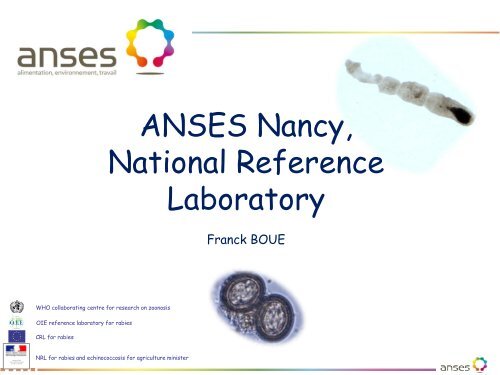
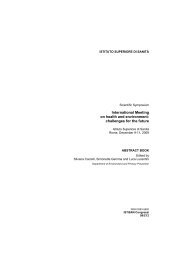
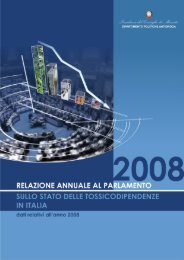
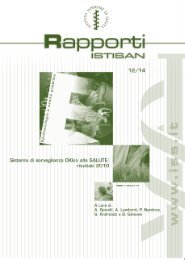
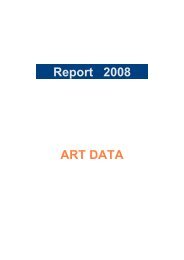
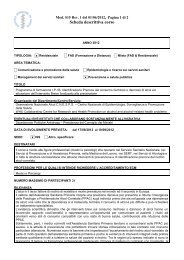
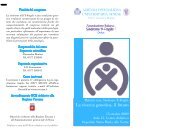
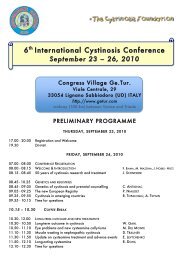
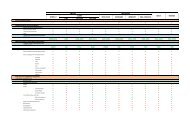
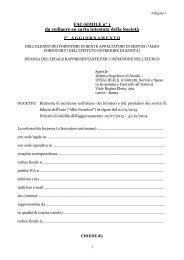
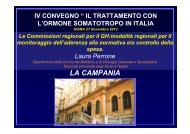
![Emilia Romagna [PDF - 175.10 kbytes]](https://img.yumpu.com/23556597/1/184x260/emilia-romagna-pdf-17510-kbytes.jpg?quality=85)
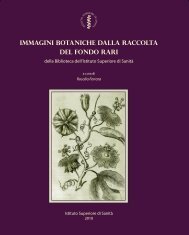
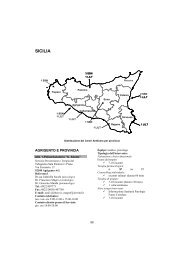
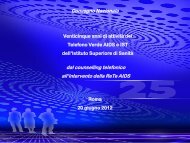
![Istisan Congressi N. 66 (Pag. 1 - 81). [PDF - 2021.12 kbytes] - Istituto ...](https://img.yumpu.com/23556493/1/171x260/istisan-congressi-n-66-pag-1-81-pdf-202112-kbytes-istituto-.jpg?quality=85)